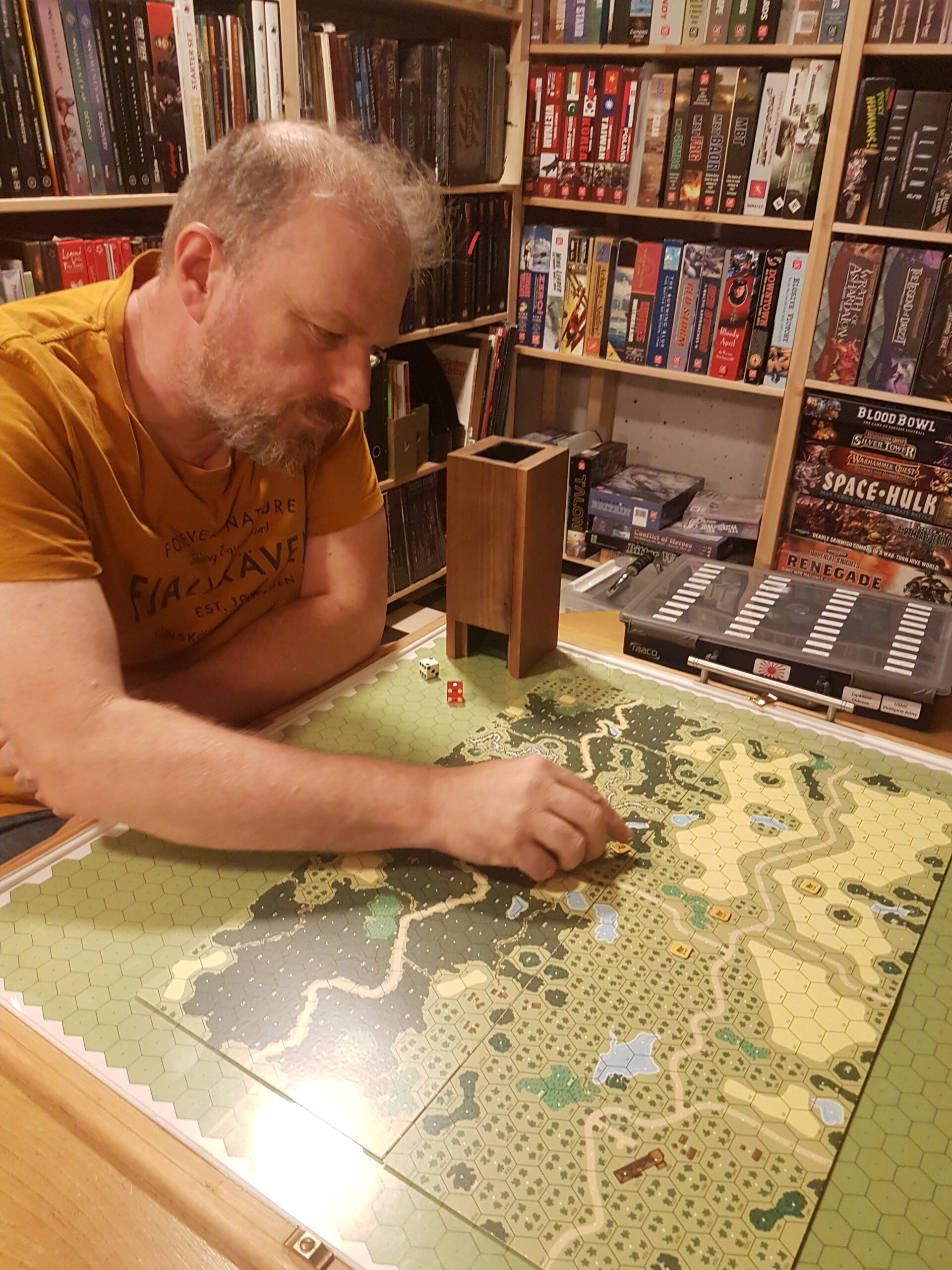
Jim’s recent article on Bocage presents the argument that the ASL rules covering our favourite Normandy terrain favours the attacker. Jim’s position aligns with my own opinion and experience. At the end of his article, he asked for other examples where the rules support the attacker, rather than the specific situation he provided. His article focusses on issues regarding (mandatory) wall advantage and LOS and is a powerful example of how the defender can be disadvantaged in a Bocage fight. My examples below focus on a simpler interaction at the infantry level and are related to movement, concealment loss and defending infantry fire options. ASL, like all good wargames is a vehicle for examining decisions and choices. I contend that the defender in Bocage often has limited options for good choices, or at least for ones that align with providing a historical feel for the defensive advantages that should accrue in the tactical situations we examine.
I should say that the examples provided are simply vignettes, not complete tactical examples. They can be criticized for not providing a more complete example of how a defender should approach an integrated defence. That is true, they are intended here to specifically highlight how the rules work and how certain interactions of those rules challenge the defender.
Example One
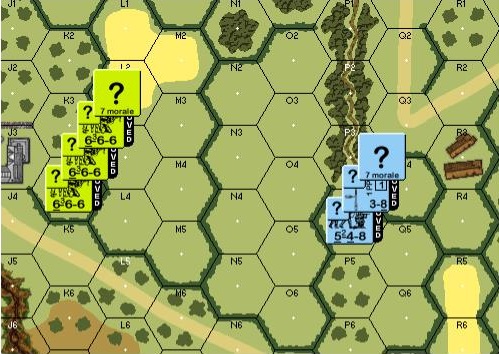
In the first example we have a German 548 + LMG defending a Bocage line against a platoon of US infantry, not a completely far-fetched example, although the force ratio may favour the attacker more than most ASL scenarios, if not historically. See Figure 1 .
The US units move up individually to the first hedgerow. As they do so they do not lose concealment, even though they are non-assault moving due to B9.55. See Figure 2.
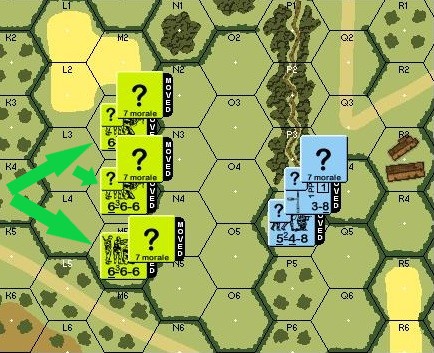
This leaves the 548 with some limited choices for Defensive first fire. He can first fire at one of the US squads with a 4 up one attack, losing his concealment in the process. This is not a great option and would usually result in the defender choosing to hold fire and maintain concealment. The US attacker has better options in advancing fire. He can elect to hold his fire with some or all units, but why would he? He can hit the Germans with either a 4 FP attack from each unbroken squad if the enemy has dropped concealment, or 3 FP from each if the German retains concealment. This essentially gives him a free shot as his choices for the rest of the turn provide some flexibility.
If he intends to press the attack by crossing the Bocage line into the open field, he may as well drop concealment anyway as he will lose it in the Advance phase. Should the German break, he is free to advance. He will grow concealment at turn end, due to being adjacent to Bocage. If he does not break the German, he can either accept the risk of being in open ground and push the advance or hold behind the Bocage and again become concealed thanks to the provision of B9.55.
The German in this situation has limited choices. Even if the US adv fire doesn’t break him it has a fair chance to strip his concealment. If stripped, he will not be able to regain until the end of his player turn. This would leave him potentially defending the Bocage line, unconcealed, facing a bunch of concealed Garands and BARS sticking out of the opposite field boundary. Skulking at this point looks like an even better option than usual. Obviously, the US still has some way to go to cross the field but Smoke and/or a 2-squad base-of-fire combined with one squad manoeuvring tactic are strong options.
Example Two
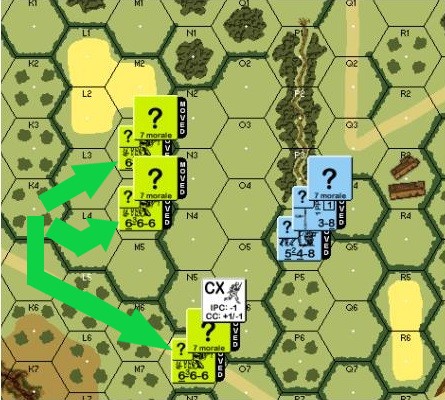
Changing the example somewhat indicates another area where Bocage can be difficult to defend, namely fields of fire. Again emphasizing this is not an optimal defence, the road would likely be covered. See Figure 3.
In this example we finish the fire and manoeuvre approach by first moving up the first 2 squads into M3 and M4 respectively. Again, the German has a tough choice, his best chance to break up a 3 hex advancing fire group is to DFF against the unit in M4 as it non-assault moves into position. This gives him a 4 up one, meh option, but he may take it rather than just wait to get beat up on in Adv Fire.
Irrespective of his decision the flanking unit will declare double-time, push through the Bocage into K5 and leg it down the road to N6. He maintains concealment, risks a 4 up one at worst and positions himself to advance into O6, where he is out of LOS due to the LOS blocking properties of Bocage Hexspines. In the APh he makes the move despite being CX as the move costs 3 MF (you can also cross Bocage into Grain or Orchard without it being an Advance vs Difficult Terrain). The German position is effectively flanked, and he would probably be wise to withdraw to the next defensive line. See Figure 4.
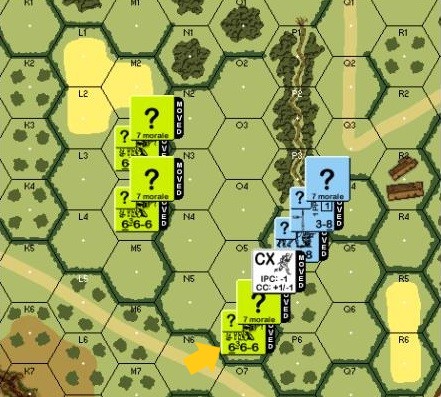
The effect of Bocage Hexspines on defender LOS often causes situations where defensive fire options are blocked, requiring (or at least forcing heavy consideration of) deploying forces out into a thinner screen than is optimal. It also allows the attacker to identify critical locations for either smoke or supporting fire. Blinding a single position can allow attackers a protected approach route due to restricted fields of fire from supporting defensive positions.
Example Three
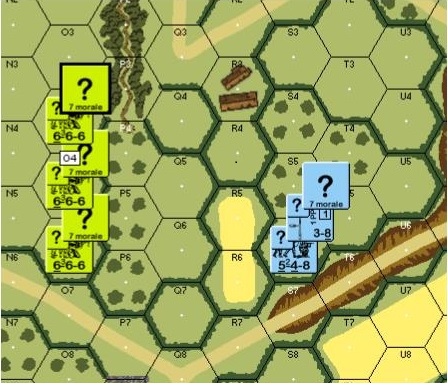
As a game progresses the defender will find himself pushed back into less-than-optimal defensive positions within the Bocage country. See Figure 5.
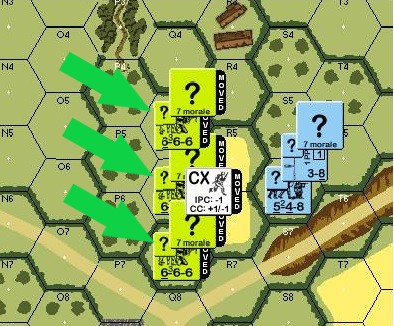
In this example the 548 would likely not setup to defend where he is, but he could very well be pushed into it by the kind of approach from the attacker that Bocage affords.
Here the attacker is in an even stronger position as the grain in R5 and R6 provides additional protection (+1 hindrance) as he moves up to the Q row assault positions. See Figure 6.
If he elects not to Adv Fire, he can retain concealment as he advances into the grain directly in front of the Germans. Not a hugely enviable position, facing down a 548 with an MG42 at point blank range but at least they are concealed and have a safe rout route, something the Germans don’t enjoy.
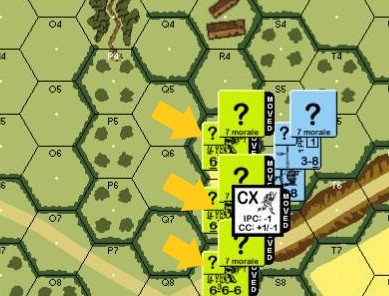
Figure 7 shows the final positions.
Observations On Bocage
When discussing the defensive advantages of Bocage in ASL the apologists (by which I mean perfectly reasonable people who disagree with my position) for the current state of the rules will often cite the defender’s options to have free shots and then disappear. These situations occur when in hex TEM (not AFV TEM) exists in combination with Bocage Hexsides. This is a valid point and these locations do provide excellent defensive positions.
However, they suffer from some drawbacks; firstly, they are relatively uncommon on most of the geomorphic Mapboards and are easily identifiable by the attacker. They should and will become the focus for the attacker’s most effective firepower and smoke laying capability and it is relatively difficult for the defender to effect surprise or ambush type engagements from them. Secondly, they afford the attacker the same advantages as the defender once secured, they allow bases of fire which can still Prep and then become invulnerable to Def Fire; a position which often benefits a scenario attacker who enjoys the usual firepower advantage associated with the offense.
I object to these rules on several grounds, firstly I don’t like the fact that they impose restrictions on units based upon an arbitrary assessment of important ground and how our cardboard comrades make that assessment. Presumably a unit can disappear from view as it pulls back a few metres into a stone farmhouse from its Bocage line as the farmhouse offers concrete refuge. I don’t see why a unit could not make the same call given a grain field, or orchard or AFV or even open ground existed behind it, if that decision made better tactical sense at the time.
I accept that this is a personal position and that the rules are the way they are. Unfortunately, I think this puts too much value on combinations of terrain that is ahistorical in nature. In Normandy everything I have read indicates that it was the hedgerows themselves that were formidable defensive positions, not structures bounded by hedgerows exclusively.
Additionally, I believe Bocage is too permissive in terms of manoeuvre. It should be much harder for vehicles to cross without bogging (Culin device notwithstanding) and should probably require a much higher infantry tariff to cross as well. The problem here is similar to the challenge associated with the PTO and discussed in the designers notes there. Reducing manoeuvre may be more accurate but doesn’t make for a fun or playable experience.
Potential Improvements
Good scenario design can mitigate many of the challenges for the defender. Adding in significant HIP capability, trenches and pillboxes as well as prepared fire zones to the defender can obviously provide a more powerful and historically credible defence but none of these fix the inherent issues with the rules as they stand. BFP, in the excellent Operation Cobra took the approach of adding in Light Bocage as a terrain type and reversing the decision that Bocage does not trigger HEAT. These rules changes don’t necessarily assist the defender, but they do demonstrate a willingness to deviate from the rules as written. This approach is obviously not immune to criticism.
I wonder if examining different design decisions could provide an alternative approach to some of the challenges inherent in the current rules. I wonder if options such as allowing defending infantry to lose concealment as per a gun when firing from Bocage, preventing non assault moving infantry from maintaining concealment behind bocage, providing the defender with infantry breaches which allow rapid crossing of hedgerows which the attacker cannot exploit (unless searched for?), allowing a unit with WA to drop it irrespective of in hex TEM etc might be worth considering. We might also consider applying only certain of the rules to the scenario defender, as we already do for Bore Sighting.
Conclusion
I should finally say that I love ASL. Despite its quirks and foibles, I don’t regret a minute I spent learning this great game. The Bocage rules are the one area that leaves me feeling that the game presents a situation that is a complete reversal of the historical experience. Maybe as a community we could examine how to fix them or at least have a constructive discussion on whether they are flawed.


Thanks for letting me publish your thoughts Phil. I appreciate it.
Some excellent suggestions for making Bocage “feel” more like it did historically; i.e.: easy to defend; hard to attack. Two of Phil’s suggestions that I think deserve the most consideration are allowing concealed infantry behind Bocage the chance to maintain concealment as per A12.34, and, even more importantly (and simply), allowing WA to be voluntarily dropped even if not in a concealment terrain hex. Of course, we all know the RB will never be changed. However, maybe future TPP could take a cue from Chas Smith at BFP and consider incorporating one or two of these ideas in future products. I think it would bring more historicity without ballooning the rules overhead.
Excellent article, Phil!
Like you, I’m amazed at how easy bocage is to move through. I think the tariff for infantry is fine, but it’s far too easy, imho, for vehicles to negotiate.
From a game perspective, I wouldn’t favour allowing infantry to drop WA in otherwise open ground. One of the best/infuriating things about ASL for me is the decisions it forces one to make.
Whilst I agree with both Phil’s and Jim’s views when it comes to Bocage I think the biggest issue faced when thinking of changing core rules is the tonne of scenarios that are now premised on the basis of the existing rules, flawed or not flawed. Those scenarios were all balanced based upon the challenges the defender faces and by changing Bocage rules could result in imbalancing many many scenarios (or ALL Bocage scenarios).
Perhaps consider any proposed/future changes to the Bocage to be optional OR when designing new Bocage scenarios they attempt to address this by SSRs, this way you can up the anti for the defenders for those particular scenarios without making redundant the many before them.
I certainly understand the concern, but they have changed many things over the years. Platoon Movement. Wall Advantage. Intensive Fire. The list goes on. Having said that, I am not personally proposing that the rules be changed. I am merely commenting that they favor the attacker in my opinion.
If I were to ever do a pack or something featuring bocage, I would likely add some SSR or specific HASL-type rules to address increase the ability of the defender to defend. But I don’t play Campaign Games so that isn’t likely to ever happen. 🙂
One option could be to allow MTR onboard to use spotting fire when not adjacent to their spotter. Defensive positions likely had the hedgerows somewhat pre-registered and local phone lines running from the front line to more rearward placed MTRs. Using normal spotting +2 DRM on the TH and treating the assaulting units as unconcealed vs the MTR should help the defender.
Chuck,
I like this idea a lot. I think it is supported by historical data related to the effectiveness of German mortars during the bocage fighting.
Regards
Phil
Very interesting thoughts from both Jim and Phil. I must admit that I love playing in bocage, either defending or attacking – I seem to do well either way:)
Though I understand the concerns that bocage can seem to favour the attacker, my argument would be that, if there is a problem, it is scenario designers who are at fault, not the rules themselves.
While an individual could commit to publishing a bocage scenario pack with their own rule changes or extensive SSR modifications (such as the spotted mortar fire mentioned above), that would likely be criticised as entering the territory of ‘grudge rules’. Certainly, the official rules will never be changed, so that seems pointless to discuss overlong.
Certain SSRs should be far more prevalent in bocage scenarios, such as allowing the defender to set up as it the opponent is attacking from off board (including gaining bore-sighting capability). I also agree that far more dummy counters should be provided to defenders, as well as HIP. One could even start taking extreme HIP options, like stating that a large percentage (or all) defending units can set up HIP if they have wall advantage over a bocage hexside (though perhaps limiting the amount of HIP within three or so hexes of the attackers set-up area). These would be simple fixes and it would be interesting to see designers start to introduce them. In fact, I know someone designing a Normandy based CG – perhaps I’ll have a word…
SSRs and such could address the “short comings” of bocage. There are plenty of scenarios (and packs) that have grudge rules in place by default.
But the fact that we both believe it takes these types of measures to simply give the defender something back is enough to tell me something isn’t modeled correctly. I think allowing the defender to cross bocage at a cost if 1 + COT would go a long way too.
Ya, not sure I agree with any of this. Bocage is VERY hard to attack though. Defender is almost always concealed. Movment costs are high. Armor is almost worthless. Not saying there aren’t some instances where it can help the attacker but overall I think it much favors the defender.
Well from my perspective, everything favors you. 😀
Every advantage/disadvantage cuts both ways, I think the cuts against the defender are much deeper. Of course, if you want to author an article, I am more than willing to host it 🙂 — jim